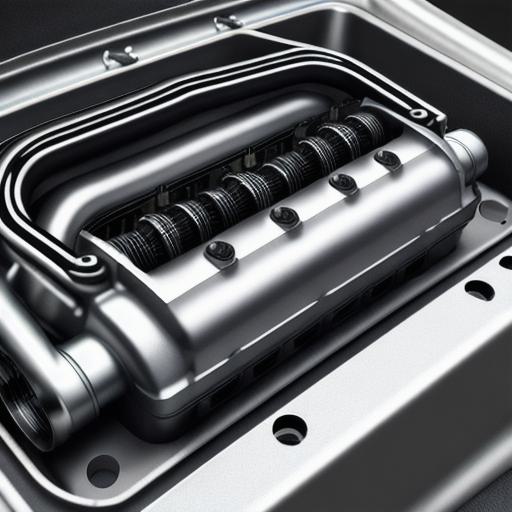In the automotive world, there are numerous components that contribute significantly to a vehicle’s performance. One such component is the wastegate exhaust manifold, specifically, a separated wastegate exhaust manifold. In this article, we will explore what a separated wastegate exhaust manifold is, how it differs from conventional manifolds, and its significance in high-performance engines.
**What is a Separated Wastegate Exhaust Manifold?
**
A wastegate exhaust manifold is a crucial component of a turbocharged engine system. In a standard turbocharging setup, the exhaust gases from the engine pass through the turbine wheel, which drives the compressor, thus increasing the air pressure and delivering more fuel to the engine for combustion. However, this process can lead to excessive backpressure in the exhaust system. To mitigate this issue, a wastegate is installed in the exhaust system, allowing excess exhaust gases to bypass the turbine wheel and reduce the boost pressure when necessary.
A separated wastegate exhaust manifold is designed to optimally manage the exhaust flow from the engine to the turbocharger and the wastegate. In this configuration, the exhaust manifolds for the cylinders and the wastegate are connected separately, allowing for better control over the exhaust gases and more efficient operation of the turbocharging system.
**Benefits of a Separated Wastegate Exhaust Manifold**
The primary benefits of using a separated wastegate exhaust manifold include:
1. Improved engine performance: By optimally managing the exhaust flow, a separated wastegate exhaust manifold can improve overall engine performance by ensuring the correct amount of boost pressure is supplied to the engine at all times. This leads to more efficient combustion and higher power output.
2. Enhanced drivability: With better control over the exhaust gases, drivers can expect improved throttle response and more consistent power delivery across the rev range.
3. Reduced emissions: By optimizing the exhaust flow and reducing backpressure in the system, a separated wastegate exhaust manifold can help reduce harmful emissions from the engine.
4. Increased reliability: The design of a separated wastegate exhaust manifold can improve the durability and reliability of the turbocharging system by reducing the stress on the exhaust components and allowing for better heat management within the system.

**Historical Context and Applications**
The use of separated wastegate exhaust manifolds can be traced back to high-performance racing engines, where optimizing engine performance and efficiency is crucial. However, this technology has become increasingly popular in the automotive industry as manufacturers continue to push the boundaries of what’s possible with internal combustion engines.
One notable example of a production vehicle using a separated wastegate exhaust manifold is the Porsche 911 GT2 RS, which features a mechanically-actuated wastegate system and optimally designed exhaust manifolds to maximize engine performance and efficiency.
**FAQs**
1. **What’s the difference between a standard wastegate manifold and a separated wastegate manifold?** A standard wastegate manifold connects the exhaust from the engine to both the turbocharger and the wastegate, while a separated wastegate manifold keeps these two systems connected separately. This allows for better control over the exhaust flow and more efficient operation of the turbocharging system.
2. **Is a separated wastegate manifold only applicable to racing engines?** No, while this technology originated in high-performance racing applications, it has since found its way into production vehicles as well, offering benefits such as improved engine performance and efficiency.
3. **How much does it cost to install a separated wastegate exhaust manifold in a car?** The cost of installing a separated wastegate exhaust manifold depends on various factors such as the vehicle’s make and model, the complexity of the installation process, and labor costs. It is generally more expensive than installing a standard wastegate manifold due to the additional engineering involved in designing and manufacturing the system.
4. **Is it possible for me to upgrade my car’s exhaust manifold to a separated wastegate design?** Installing a separated wastegate exhaust manifold on your vehicle can be a complex process that may require specialized knowledge and resources. It is recommended that you consult with a professional mechanic or turbocharging expert to determine if this upgrade is feasible for your specific application.
5. **What are the potential downsides of using a separated wastegate exhaust manifold?** While there are numerous benefits to using a separated wastegate exhaust manifold, there are also some potential drawbacks. These include increased cost, complexity, and the need for more precise engine tuning to ensure optimal performance. Additionally, this technology may not be suitable for all applications, especially those with lower power outputs or less demanding driving conditions.
**Conclusion**
In conclusion, a separated wastegate exhaust manifold is an advanced engineering solution designed to optimize the performance of turbocharged engines. By managing the exhaust flow from the engine to the turbocharger and wastegate separately, this technology can improve engine efficiency, reduce emissions, and enhance drivability. Its origins in high-performance racing applications have led to its increasing popularity in the automotive industry, with production vehicles such as the Porsche 911 GT2 RS adopting this design to push the boundaries of what’s possible with internal combustion engines. However, it is essential to consider the potential costs and complexities involved in implementing this technology for your specific application.
